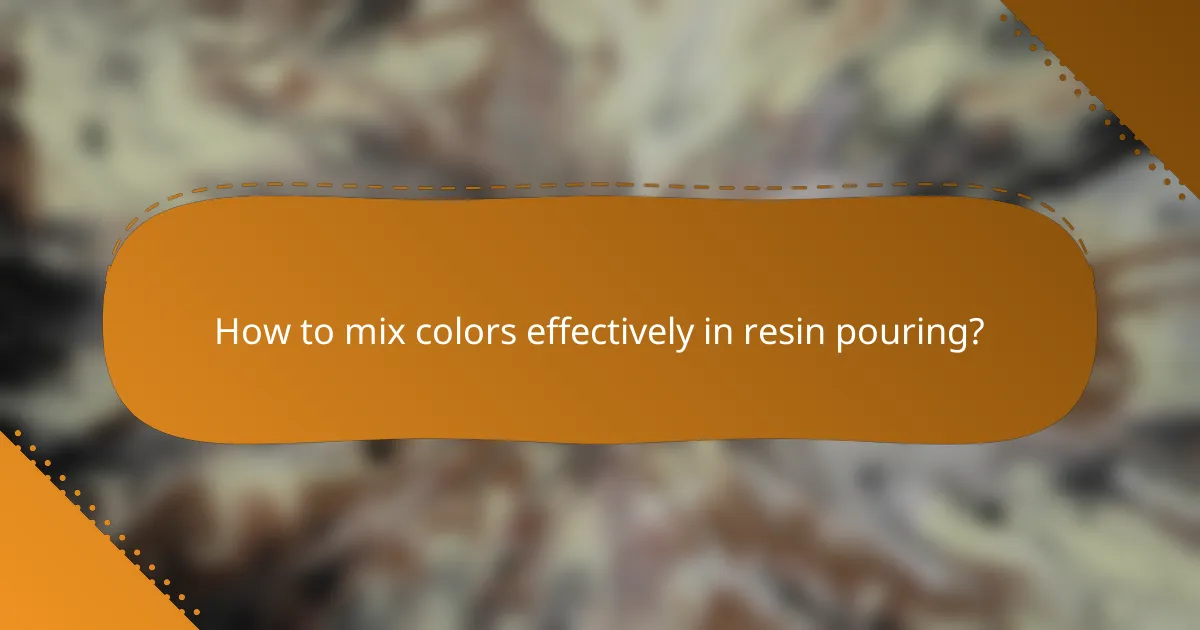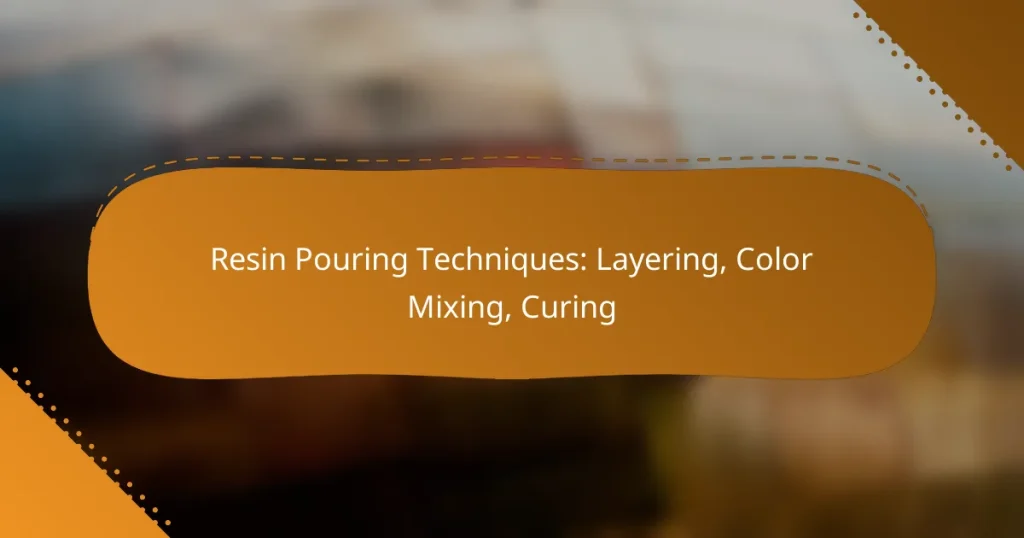Resin pouring techniques, such as layering and color mixing, can create stunning visual effects in your projects. By carefully planning your layers and selecting high-quality pigments, you can achieve depth and uniformity in your designs. Additionally, understanding the curing process is essential for ensuring that your resin sets properly and maintains its durability over time.

What are the best resin pouring techniques for layering?
The best resin pouring techniques for layering involve careful planning and execution to create visually appealing effects. Key methods include using clear and colored resins, employing molds, and manipulating the curing process to achieve depth and dimension.
Layering with clear resin
Layering with clear resin allows for a clean and polished finish, enhancing the visibility of embedded objects or colors beneath. Start by pouring a thin layer, allowing it to cure partially before adding the next layer. This technique helps prevent mixing and maintains distinct layers.
Consider using a heat gun to eliminate bubbles and ensure a smooth surface. It’s essential to monitor the curing time, as different resins may have varying pot lives and cure times, typically ranging from several hours to a day.
Layering with colored resin
Using colored resin for layering adds vibrancy and depth to your projects. Mix pigments or dyes into the resin before pouring, ensuring even distribution for consistent color. Pour each layer separately, allowing the previous layer to cure to avoid muddling the colors.
Experiment with different shades and opacities to create unique effects. Remember that darker colors may require more resin to achieve the desired opacity, while lighter colors can be more translucent.
Using molds for layering
Molds are a practical tool for creating layered resin pieces, allowing for precise shapes and sizes. Choose molds that are compatible with resin and can withstand the heat generated during curing. Pour the first layer and let it cure before adding subsequent layers.
Ensure that each layer is poured at the right viscosity; too thick can cause uneven layers, while too thin may lead to mixing. Silicone molds are often preferred for their flexibility and ease of release.
Creating depth with layering
To create depth in your layered resin projects, consider varying the thickness of each layer. Thicker layers can provide a more pronounced effect, while thinner layers can create a subtle gradient. Use clear resin as a base to enhance the depth of colored layers on top.
Incorporating objects like flowers, glitter, or stones between layers can further enhance the three-dimensional effect. Be mindful of the curing times to ensure that each layer bonds properly without trapping air bubbles.

How to mix colors effectively in resin pouring?
To mix colors effectively in resin pouring, start by selecting high-quality pigments or dyes that are compatible with your resin type. Ensure you mix thoroughly to achieve a uniform color and avoid any clumping or separation during the curing process.
Using alcohol inks for color mixing
Alcohol inks are vibrant and versatile for resin projects, allowing for stunning color effects. They can be added directly to the resin mixture, but use them sparingly, as a little goes a long way. Aim for a few drops at a time, mixing thoroughly to achieve the desired shade.
Keep in mind that alcohol inks can create translucent effects, which may be ideal for layering techniques. Experiment with different colors to see how they blend together, but avoid over-mixing to maintain some depth and variation.
Mixing pigments with resin
When mixing pigments with resin, choose either powdered pigments or liquid dyes specifically designed for resin use. Start by adding a small amount of pigment to your resin and stir well, gradually increasing the amount until you reach the desired opacity and color intensity.
It’s essential to ensure that the pigment is fully incorporated to prevent any clumping. For best results, aim for a pigment-to-resin ratio of around 5-10% by weight, adjusting based on the specific pigment’s strength and your project needs.
Creating custom color palettes
Creating custom color palettes for resin pouring involves selecting complementary colors that work well together. Start by choosing a base color and then select one or two accent colors that enhance it. Consider using a color wheel to identify harmonious combinations.
To test your palette, mix small batches of resin with your chosen colors and pour them onto a sample surface. This allows you to see how the colors interact when cured. Keep a record of your ratios for future reference, ensuring consistency in your projects.

What are the curing processes for resin?
Curing processes for resin involve chemical reactions that transform liquid resin into a solid state, typically through heat or time. Understanding these processes is crucial for achieving the desired finish and durability in resin projects.
Understanding curing times
Curing times for resin can vary significantly based on the type of resin used and environmental conditions. Generally, epoxy resins may take anywhere from a few hours to several days to fully cure, while polyurethane resins often cure faster, sometimes within a few hours. It’s essential to follow the manufacturer’s guidelines for optimal results.
To ensure proper curing, consider factors such as the thickness of the pour and the specific formulation of the resin. Thicker layers may require longer curing times, so plan accordingly to avoid issues like incomplete hardening.
Temperature effects on curing
Temperature plays a critical role in the curing process of resin. Most resins cure best at room temperature, typically between 20°C and 25°C (68°F to 77°F). Lower temperatures can slow down the curing process, leading to longer wait times and potential issues with the final product.
Conversely, higher temperatures can accelerate curing but may also lead to exothermic reactions, causing the resin to overheat and potentially warp or crack. It’s advisable to monitor the temperature closely and work within the recommended range for the specific resin being used.
Post-curing techniques
Post-curing refers to additional curing steps taken after the initial hardening of the resin to enhance its properties. This can involve heating the cured resin in an oven at a controlled temperature to improve hardness and chemical resistance. Post-curing is particularly beneficial for industrial applications where durability is crucial.
Another technique is to allow the resin to cure in a controlled environment with stable humidity and temperature, which can help reduce imperfections. Always ensure that the resin is fully cured before applying any post-curing methods to avoid compromising the integrity of the final product.

What tools are essential for resin pouring?
Essential tools for resin pouring include mixing containers, stir sticks, and molds. These tools help ensure proper mixing and shaping of the resin, leading to successful projects.
Recommended mixing tools
For effective resin mixing, use clear plastic cups or silicone mixing containers to easily measure and pour the resin. Stir sticks, preferably wooden or silicone, are ideal for blending the resin and hardener thoroughly, which is crucial for proper curing.
Consider using a scale for precise measurements, especially when working with larger batches. This ensures that the resin-to-hardener ratio is accurate, preventing issues like incomplete curing.
Best molds for resin projects
Silicone molds are the most popular choice for resin projects due to their flexibility and ease of use. They allow for easy removal of the cured resin and come in various shapes and sizes, catering to different project needs.
For intricate designs, consider using molds specifically designed for resin, which often have detailed patterns. Ensure the mold is clean and free of dust before pouring to achieve a smooth finish.
Protective gear for resin work
When working with resin, wearing protective gear is essential to ensure safety. Use gloves to protect your hands from potential skin irritation and a mask to avoid inhaling fumes, especially in poorly ventilated areas.
Additionally, goggles can protect your eyes from splashes. Always work in a well-ventilated space and consider using a respirator for added safety, particularly with larger projects or when using colored resins that may emit stronger odors.

What are common mistakes in resin pouring?
Common mistakes in resin pouring include overheating during curing and using incorrect resin-to-hardener ratios. These errors can lead to poor results, such as bubbles, uneven surfaces, or incomplete curing.
Overheating during curing
Overheating occurs when the resin generates excessive heat during the curing process, often due to a thick pour or inadequate ventilation. This can cause the resin to cure too quickly, leading to cracks or warping.
To avoid overheating, consider pouring in thinner layers, typically no more than 1/4 inch thick, and ensure proper airflow around your workspace. Monitoring the temperature can also help; aim for a stable environment between 20-25°C (68-77°F).
Incorrect resin-to-hardener ratios
Using the wrong resin-to-hardener ratio can result in a sticky finish or incomplete curing. Most epoxy resins require precise measurements, often in a 1:1 or 2:1 ratio, depending on the product.
Always refer to the manufacturer’s instructions for the specific resin you are using. A digital scale can help ensure accuracy, and it’s advisable to mix small test batches to confirm the correct ratio before proceeding with larger pours.


